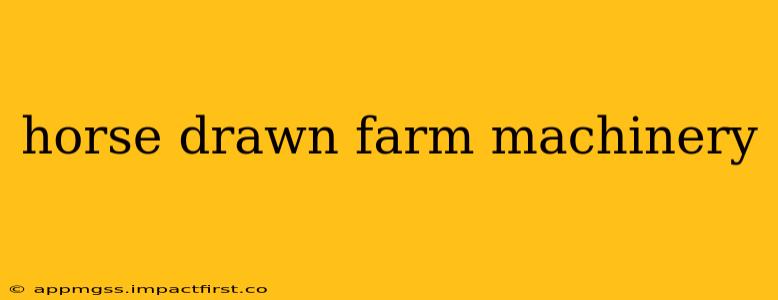For centuries, the horse was the backbone of agriculture, powering a diverse array of machinery that shaped farming practices and landscapes. Before the internal combustion engine revolutionized agriculture, horse-drawn farm machinery represented the pinnacle of technological advancement in food production. This exploration delves into the fascinating world of horse-drawn implements, examining their ingenuity, impact, and enduring legacy.
What types of horse-drawn farm machinery were there?
The variety of horse-drawn farm machinery was surprisingly extensive, reflecting the diverse needs of farming operations. Common implements included:
-
Plows: From simple moldboard plows that turned over soil for planting to more sophisticated designs like the chilled plow (which minimized soil friction), plows were crucial for preparing the land. The number of horses required depended on the soil type and the plow's size.
-
Harrows: Used to level and smooth the soil after plowing, harrows came in various designs, including chain harrows, spring-tooth harrows, and disk harrows, each with its own advantages for different soil conditions.
-
Seed Drills: These innovative machines allowed for precise planting of seeds, improving efficiency and yield compared to broadcasting seeds by hand. They could be adjusted to plant different seed types and at varying depths.
-
Reapers: These mechanical marvels revolutionized harvesting, significantly reducing the labor needed to cut grain. Early reapers were relatively simple, but they evolved to become more efficient and capable of handling larger fields.
-
Threshing Machines: While often horse-powered indirectly (using a belt and pulley system), threshing machines were essential for separating grain from the stalks. This process significantly sped up post-harvest operations.
-
Wagons and Carts: Essential for transporting harvested crops, supplies, and equipment across the farm. Different designs catered to specific needs, from flatbeds for hauling hay to specialized carts for transporting delicate produce.
How many horses were needed to operate farm machinery?
The number of horses needed varied greatly depending on the implement's size and weight, the soil conditions, and the terrain. A single horse could manage lighter tasks like harrowing or operating smaller plows, while heavier equipment like large plows or threshing machines might require two, three, or even four horses working together. Proper harnessing and teamwork between the horses were essential for efficient operation.
What were the advantages and disadvantages of using horse-drawn farm machinery?
Advantages:
- Relatively low cost: Compared to early mechanized equipment, horse-drawn implements were more affordable and accessible to smaller farms.
- Sustainable: Horses provided a renewable and sustainable power source, reducing reliance on fossil fuels.
- Versatility: Horses could perform a wide range of tasks beyond pulling machinery, contributing to overall farm operations.
- Lower maintenance: Horses, while requiring care, generally needed less maintenance than complex machinery.
Disadvantages:
- Limited power: Horses were limited in the power they could generate, restricting the size and capability of the machinery they could pull.
- Labor intensive: Operating horse-drawn machinery still required significant manual labor, particularly in tasks like guiding the equipment and handling the horses.
- Weather dependent: Work was subject to weather conditions that affected the horses' performance and the viability of fieldwork.
- Slower work pace: Compared to modern machinery, horse-drawn implements worked at a significantly slower pace.
How did horse-drawn farm machinery impact farming practices?
Horse-drawn farm machinery significantly impacted farming practices by:
- Increasing efficiency: It reduced the labor needed for many tasks, allowing farmers to cultivate and harvest larger areas.
- Improving yields: More efficient planting and harvesting led to improved crop yields and greater food production.
- Shaping landscapes: The use of plows and other implements dramatically altered the land, facilitating large-scale farming practices.
- Enabling technological advancement: The development of horse-drawn machinery paved the way for the later development of more powerful, mechanized equipment.
When did horse-drawn farm machinery become obsolete?
The widespread adoption of gasoline-powered tractors in the early to mid-20th century gradually rendered horse-drawn machinery obsolete. While some horse-drawn equipment remains in use on smaller farms or for specific tasks, the internal combustion engine provided a more powerful, efficient, and less labor-intensive alternative, marking a turning point in agricultural technology. However, the ingenuity and impact of horse-drawn farm machinery continue to be recognized as a pivotal chapter in agricultural history.
